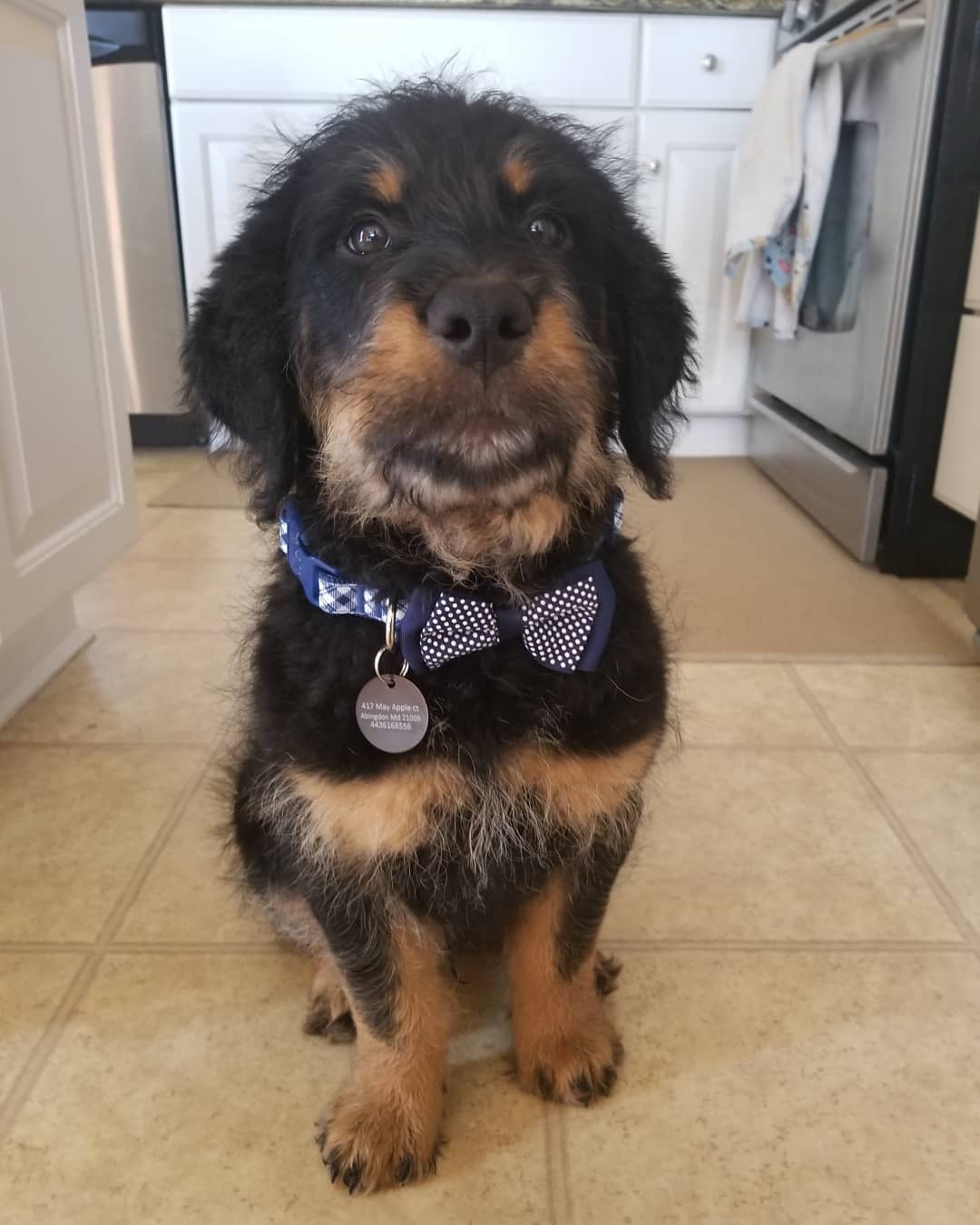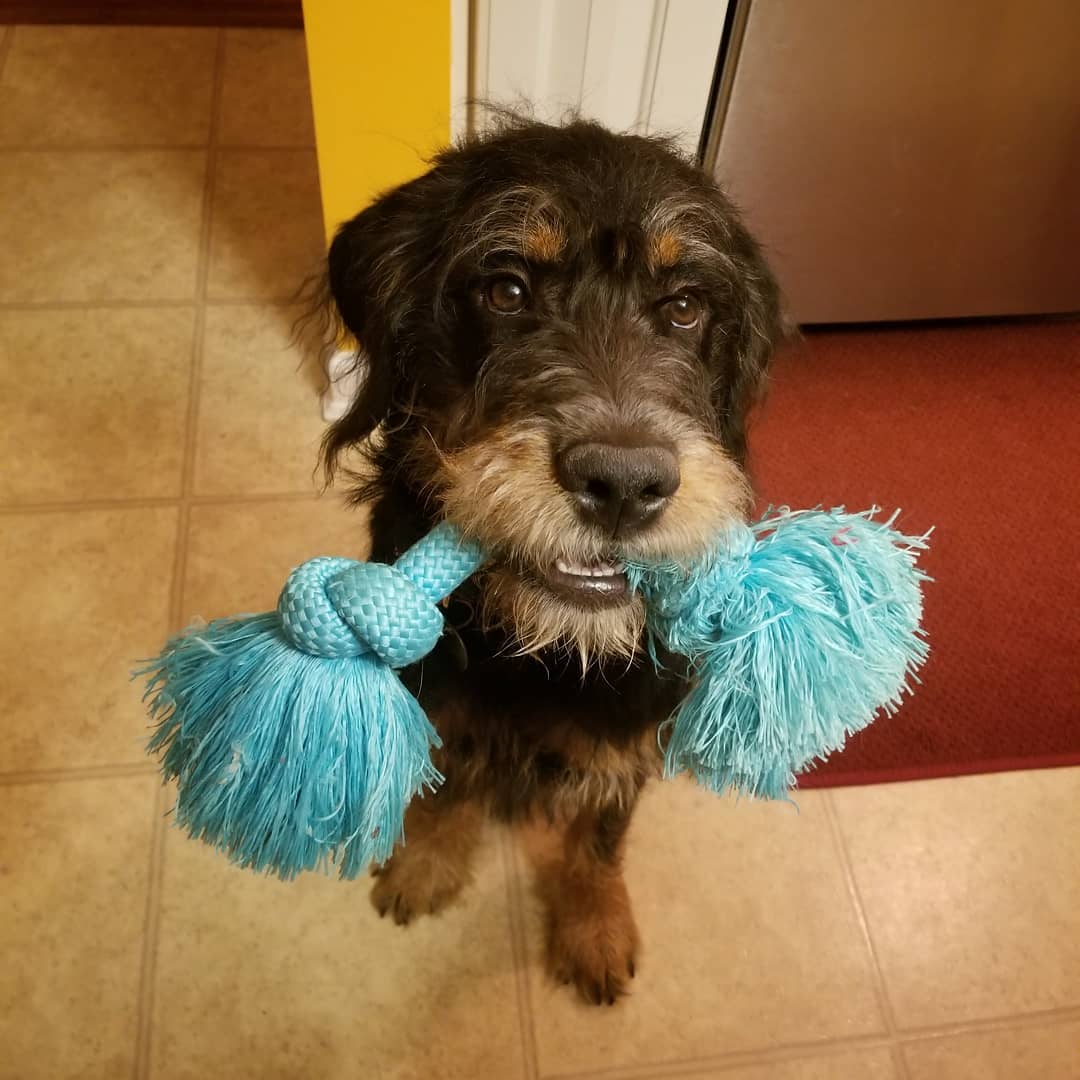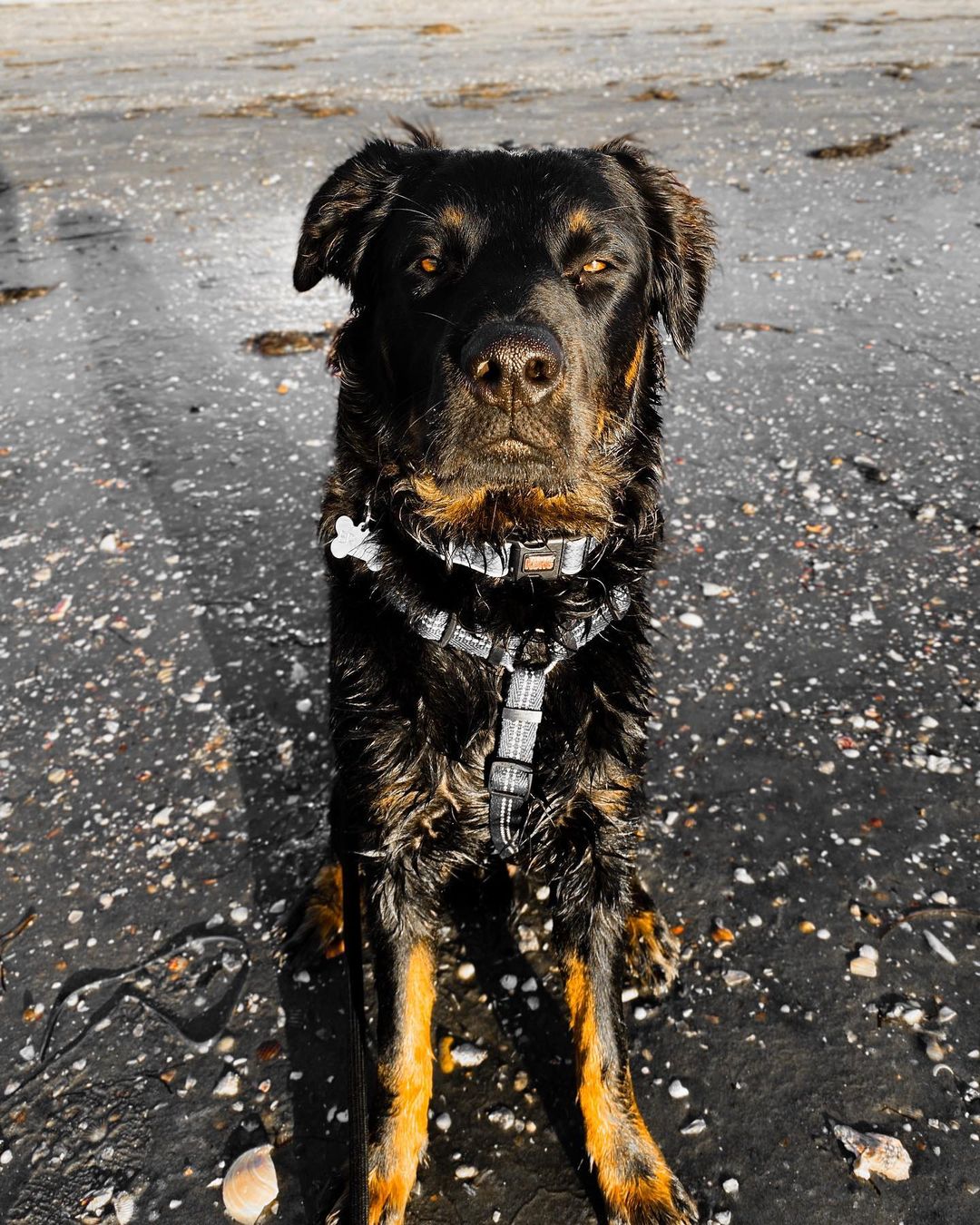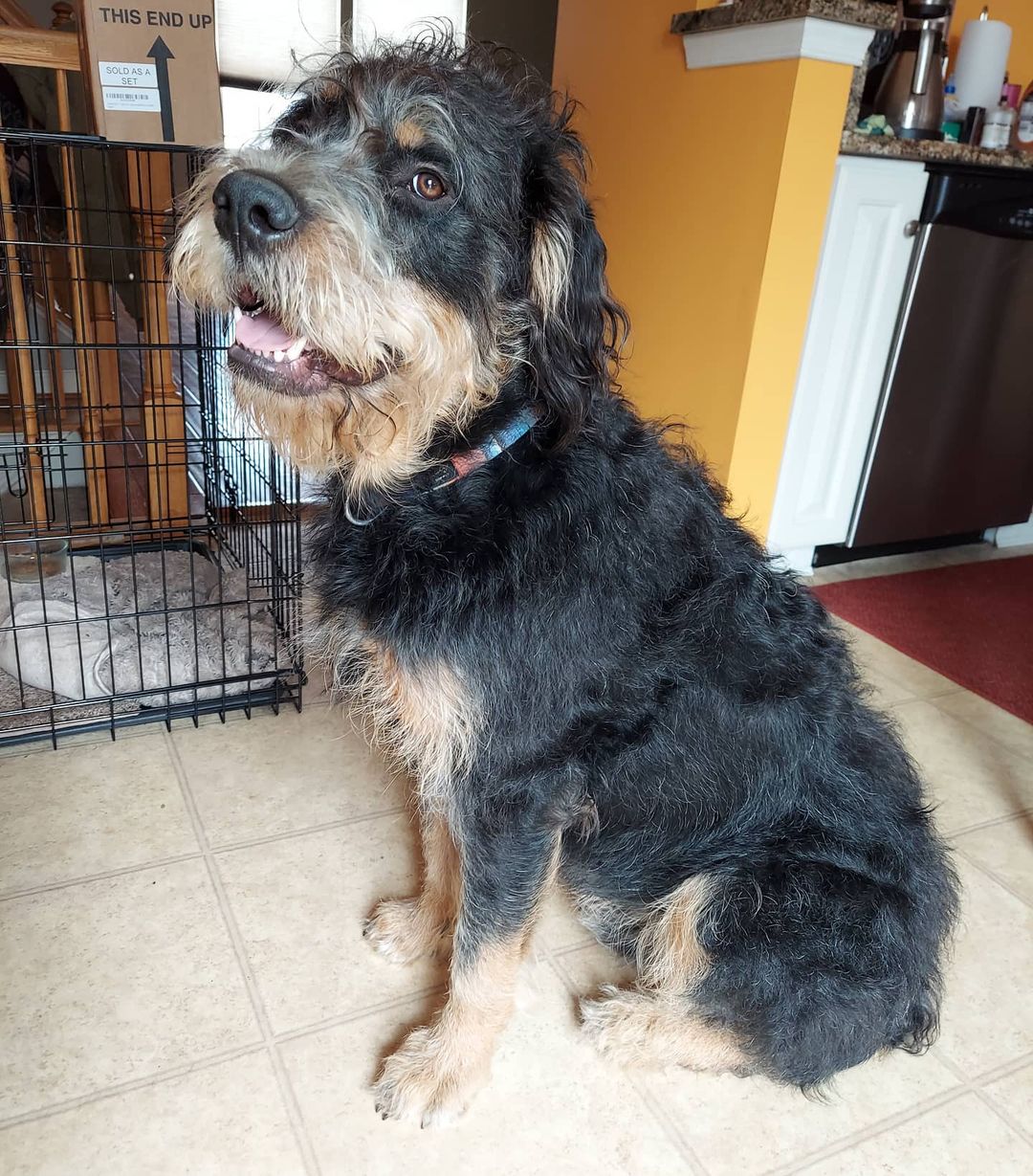Have you ever heard of a Rottle? It’s the new name for the tough Rottweiler poodle mix.
The Rottweiler was the AKC’s most popular dog in 2017, so it only makes sense that the Rottle, also known as the Rottie Poo or Rottie Doodle, would be a popular mix.
Mixes, especially poodle mixes, are all the rage these days, and that’s not surprising.
After all, the poodle, including all three size variations, was the AKC’s 7th “popular dog” in the year.
Everyone knows the Labradoodle ”. and are also popular favorites.
But there are also stronger, more sporty mixes like the Bernedoodle ”.
Of course, some people aren’t fans of so-called “designer dogs” at all.
What is a Rottle
The Rottle is a mixed breed formed from a Rottweiler with a Poodle. As a mixture, they can vary greatly. From 15 and 27 inches tall and 60 and 130 pounds in weight. As a breed of dog, they can also have a varied temperament. Let’s find out more about them!
But what exactly is a designer dog?
Designer dogs are the result of an intentional mixture of different purebred dog breeds. This creates a cross with a mixture of the characteristics of the two parent breeds.
Some purebred dog lovers claim “that breeding designer dog is unethical because it creates unhealthy dogs that breeders make too much money for.”
In reality, mixed breed dogs are less likely to experience health problems than purebred dogs.
Since rearing purebreds requires inbreeding, it results in unhealthy dogs who are at high risk of inheriting the same health problem from both sides. On the other hand, breeding two different breeds of dogs brings with it genetic diversity that is “too healthy for”.
The tradeoff is that since traits can be inherited from either parent breed, the traits of mixed-breed dogs can be difficult to predict.
Of course, when the two parent breeds are similar, the traits of their offspring are more predictable, but similar parent breeds often have similar health issues as well.
But we’re here today to talk about the Rottweiler and Poodle mix, so let’s get started!
Poodle story
Although the poodle is most commonly associated with France, both rottweilers and poodles have their origins in Germany.
Despite its reputation as a vicious dog, the standard poodle was bred to collect ducks for hunters before the fifteenth century.
In fact, the famous poodle clip was developed by hunters who wanted to give their poodles greater freedom of movement while swimming but also wanted to adequately isolate important organs and joints from cold water.
Rottweiler story
The origins of the Rottweiler come as a surprise to many.
Although the breed is often viewed as a guard dog, it actually originated as a herding breed that brings cattle to the market.
Once locomotives became the preferred way of moving cattle, the Rottweiler lost its popularity. However, their protective instincts quickly made them popular again as police, military, and guard dogs.
As with most mixed breeds, pinpointing the exact origins of the Rottie Poodle mix is difficult. The first known Rottweiler mixed poodle puppies were born in Germany in the 1980s, but other Rottle puppies may have been born earlier.
How big is a Rottle?
A Rottle can be between 15 and 27 inches tall and weigh between 60 and 130 pounds. In order to estimate the size of a mixed breed, we must first consider the size of the two parent breeds.
A male Rottweiler can be 24 to 27 inches tall at the withers, while female Rottweilers are typically 22 to 25 inches tall. Standard poodles range in height from 15 to 24 inches.
Male rottweilers weigh between 110 and 130 pounds while female rottweilers weigh between 77 and 110 pounds.
Poodles are quite slender by comparison, standard male poodles weighing 60 to 70 pounds and females 40 to 50 pounds.
An adult female Rottle dog can be between 15 and 25 inches tall and between 40 and 110 pounds in weight.
However, most Rottie Poo puppies will fall in the middle of these areas, between 20 to 25 inches tall and 75 to 100 pounds in weight. Of course, there are Rottweiler Poodle mixes that fall to the extremes, but they’re not typical.
A standard large poodle and small rottweiler are more likely to produce offspring that will grow in the middle, but extremes are still possible here.
The Rottle coat
The poodle’s fur is one of the most standout features. The poodle has a thick, curly coat that sheds very little.
A common myth is that the poodle is hypoallergenic because it is hardly shed. Unfortunately, the allergen is in dander and saliva, not hair, so no breed of dog is completely allergy-friendly.
The Rottweiler has a straight, coarse, dense, medium-length outer coat with an undercoat around the neck and thighs.
Rottweilers are light seasonal shedders.
Expect a Rottweiler Poodle mix with lots of fur, which can be wavy or curly in texture, and of medium to long length.
Despite that dense coat, a Rottie Poo will lose very little weight. An undercoat may or may not be present.
The Rottweiler Cross-breed Poodle can have a variety of coat colors, including black, gray, brown, red, cream, blue, white, and bat.
How do you care for a Rottle?
The “poodle’s coat” is known to be easy to care for. The presence of the Rottweiler’s genes can make the coat of the Rottweiler and Poodle mix a little easier to manage, but it still requires a lot of grooming.
Having your Rottie Poodle mix cut short will make grooming easier. Some owners cut their standard Rottweiler poodle mix themselves. Others prefer to take their Rottie Poo to the groomer every four to six weeks for full bathing and grooming.
If you prefer to keep your Rottie Doodle with a long coat on, you will need to brush your Rottle dog daily to prevent matting.
Brushing your teeth twice a day may be necessary during the seasons.
Rottle temperament and demeanor
The Rottweiler Cross-Poodle is calm, alert, and confident.
The Rottweiler and Poodle mix can be cautious and reserved for strangers.
The Rottie Poodle mix is playful, loving, and silly. The Rottie Doodle is very loyal to its family and can serve as a guardian for the family, especially children. The Rottweiler can be very cuddly and tries to act like a lap dog.
However, the Rottweiler Standard Poodle mix should never be left alone with children. Since this is a large dog, it can inadvertently harm young children. Children can also try playing to rough litter while playing with a mix of rottweiler and poodle, which can encourage aggression.
The Rottweiler Poodle mix typically doesn’t like being alone but is not prone to separation anxiety.
Requirements for the training and the training of Rottle
The Rottweiler and Poodle are both some of the most intelligent dog breeds, so the Rottie Poodle mix is also particularly bright.
The Rottie Doodle is immensely adaptive and wants you to like it, but it can be persistent. Early socialization and training are essential to forming a well-done Rottie Poodle mix, as is leading your leadership role quickly.
Consistency is key when training and socializing a Rottweiler Poodle mix.
Introducing the Rottle to a variety of new people and experiences as early as possible will help you learn in your Rottweiler and Poodle mix. This can also help prevent aggression from strangers.
The Rottle is a mix of two athletic breeds, which is why daily training is essential.
Oftentimes, swimming is a popular pastime of the Rottweiler Standard Poodle mixes. They also enjoy long walks, hikes, or jobs with their favorite people. Retrieval games can also be a fun way to exercise a rottweiler cross poodle.
The Rottweiler Poodle mix excels at dog sports such as agility, tracking, and obedience, which can be excellent ways to exercise the Rottie Doodle’s body and mind.
Rottweiler health
To identify potential health issues for the Rottweiler Poodle mix, we need to look at the health issues of each parent breed.
As with most large breeds of dogs, one of the most common health problems in Rottweilers is h and elbow dysplasia.
Dysplasia is a congenital condition that occurs when a joint does not form properly. Hip dysplasia affects more than 20 percent of Rottweilers, while elbow dysplasia affects almost 40 percent, according to the Orthopedic Foundation for Animals.
Osteochondritis dissecans (OD) is another joint disease that is common in Rottweilers. OD is characterized by cracks in the articular cartilage and subchondral bone of the joint that causes pain and swelling.
Rottweilers are disproportionately at risk of heart disease, cardiomyopathy, and subaortic stenosis.
Dilated cardiomyopathy occurs when the heart walls are thin, interfere with heart function, and possibly lead to heart failure. Typically there are no outward signs of heart failure, but the EKG can be used to detect expanded cardiomyopathy.
Subaortic stenosis refers to the development of a ring of abnormal tissue around the valve to the aorta that obstructs blood flow and results in a heart murmur. To make up for this, the heart has to work harder, which can lead to exhaustion, breakdown, and heart failure.
Progressive retinal atrophy (PRA), which is characterized by the gradual breakdown of the retina, impairing vision, and possibly leading to total blindness, is also particularly common in Rottweilers.
Osteosarcoma, or bone cancer, is one of the leading causes of death, especially early death, in Rottweilers.
Rottweilers have a life expectancy of 8 to 10 years.
Standard poodle health
Standard poodles suffer from joint problems, including hip dysplasia and patellar luxation.
“Patellar Luxation” occurs when the patella shifts. Patellar luxation is generally congenital but can also be caused by trauma with blunt KR.>
Addison’s disease, a condition in which the adrenal gland does not make enough hormones, is common in poodles. Addison’s disease causes a number of symptoms including lethargy, gastrointestinal discomfort, and poor tolerance to stress.
Standard poodles are also prone to thyroid problems, including hypothyroidism and hyperthyroidism, which are characterized by over- and under-production of thyroid hormones, respectively.
Von Willebrand “disease a blood clotting stiff occurs in poodles more than other breeds.>
Poodles are also one of the most endangered breeds for blooming, the expansion of the stomach after being fed with water or air. this can also cause the stomach to pull out the pressure on the surrounding organs and also cause it. therefore, immediate assistance is required to inflate to prevent death.>
Poodles suffer particularly often from epilepsy “a disease that is characterized by” Anf “without any recognizable cause.>
Poodles are also at risk for certain eye conditions, including progressive retinal atrophy and corneal dystrophy.
Corneal dystrophy occurs when substances from the body, such as fats and cholesterol, build up in the cornea and affect eyesight.
Standard poodles have a lifespan of 11 to 12 years.
Are Rottles Healthy Dogs?
The top health concerns for the Rottle are PRA and hip dysplasia as both breeds suffer from it.
However, the Rottweiler-Poodle mix is at risk with a few other breed health issues.
The Rottie Poo has a potential lifespan of 8 to 12 years, but the average is more in the medium range (around 10 years). Major health conditions can shorten an individual dog’s lifespan.
Choice of mixed rottweiler-poodle puppies
The first step in raising a healthy Rottle dog is choosing healthy Rottle puppies. Healthy Rottle puppies come from healthy parents.
OFA recommends that Rottweilers be tested for hip dysplasia, elbow dysplasia, visual disturbances, and heart problems before breeding. Poodles should be tested for hip dysplasia, vision problems, heart problems, and thyroid problems.
Any ethical breeder can provide you with the results of these tests, but the results should also be registered with a canine health registry such as the OFA.
Parents should be at least two years old for these tests to be accurate and for the best chance of producing healthy babies.
Due to the difference in size in the Rottweiler and Poodle, the mother should be the Rottweiler, as giving birth to puppies that are too large can be dangerous for a standard poodle.
The breeder should make it possible for you to meet the mother as well as any remaining puppies in the litter. You should all look happy and healthy. You should also be given information about the father and the breeder who owns it.
All dogs owned by the breeder should be farm animals or beloved pets and should not be treated simply as business assets.









